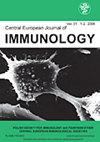Hematopoietic stem cell transplantation in a patient with activated phosphoinositide 3‑kinase δ syndrome: A case report and literature review
IF 1.6
4区 医学
Q4 IMMUNOLOGY
引用次数: 0
Abstract
Activated phosphoinositide 3-kinase δ syndrome (APDS) is a recently described disease characterized by recurrent infections, lymphoproliferation with a high risk of malignancy, early-onset cytopenia, and a propensity for autoimmune diseases. Hematopoietic stem cell transplantation (HSCT) has proven to be an effective treatment method; however, the recovery process after HSCT is prolonged and accompanied by complications. In this study, we present the case of a patient with APDS type 1. Despite showing signs of immunodeficiency at the age of 6 months, it took almost 6 years to reach a definitive diagnosis. The patient experienced recurrent infections, often accompanied by anemia requiring transfusions, and multifocal nonmalignant lymphoproliferation. Only after receiving the appropriate diagnosis was it possible to implement proper and accurate treatment. HSCT was performed when the patient was 6 years old, leading to significant improvement in his condition. At the 17-month post-HSCT follow-up, the boy is asymptomatic and in good general health, although close monitoring continues due to mixed chimerism and delayed humoral immune recovery. Applying HSCT before the patient develops malignancy contributes to expanding the use of HSCT as a treatment option for APDS type 1.活化磷酸肌酸 3- 激酶 δ 综合征患者的造血干细胞移植:病例报告与文献综述
活化磷酸肌酸 3- 激酶δ综合征(APDS)是最近描述的一种疾病,其特点是反复感染、淋巴细胞增生(恶性肿瘤风险高)、早发全血细胞减少症和自身免疫性疾病倾向。造血干细胞移植(HSCT)已被证明是一种有效的治疗方法;然而,造血干细胞移植后的恢复过程漫长且伴有并发症。在本研究中,我们介绍了一名 APDS 1 型患者的病例。尽管患者在 6 个月大时就出现了免疫缺陷的症状,但经过近 6 年的时间才得到明确诊断。患者反复感染,经常伴有贫血,需要输血,并出现多灶性非恶性淋巴细胞增生。只有在得到适当的诊断后,才有可能实施适当而准确的治疗。患者在 6 岁时接受了造血干细胞移植,病情明显好转。在造血干细胞移植后 17 个月的随访中,男孩没有任何症状,总体健康状况良好,但由于混合嵌合体和体液免疫恢复延迟,仍需继续密切监测。在患者发生恶性肿瘤之前进行造血干细胞移植,有助于扩大造血干细胞移植在治疗 APDS 1 型中的应用。
本文章由计算机程序翻译,如有差异,请以英文原文为准。
求助全文
约1分钟内获得全文
求助全文
来源期刊

Central European Journal of Immunology
IMMUNOLOGY-
CiteScore
3.00
自引率
0.00%
发文量
17
审稿时长
6-12 weeks
期刊介绍:
Central European Journal of Immunology is a English-language quarterly aimed mainly at immunologists.
 求助内容:
求助内容: 应助结果提醒方式:
应助结果提醒方式:


